The average horsepower of silage harvesters in Ireland has increased in recent years. This is often due to challenging weather conditions leaving contractors to gather up more grass in a shorter time period. This higher throughput requires greater-capacity machines. Farmers cutting grass early in the season generally look for quality and maybe an extra cut; this leaves lighter crops on the ground in a lot of cases.
In recent years, contractors have been making the move to larger rakes to speed up the process as more grass is being grouped into the one row, resulting in less driving.
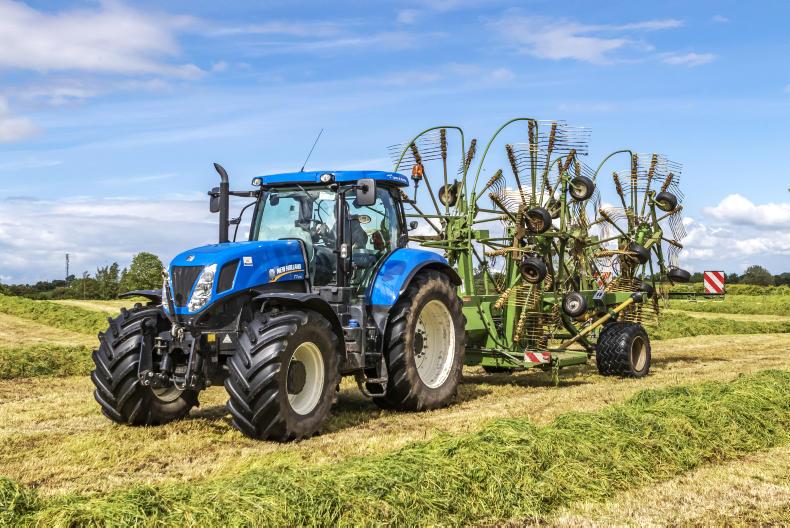
Stephen Mohan's Krone Swadro 1400 and New Holland T7.235
Krone Swadro 1400
Stephen Mohan is a contractor based in Navan, Co Meath. He operates a Krone Swadro 1400 four-rotor rake after moving from a Swadro 900. Stephen said his main reasons for opting for the larger rake was that crops were lighter due to earlier cutting, as his customers were focusing more on quality. He said: “Farmers were cutting that bit earlier, crops were lighter and we found ourselves chasing the rows around the field.” They now work at steadier speeds and lift greater volumes of grass.
Stephen’s Krone 1400 rake is capable of pulling in 13.5m of tedded grass or five 10ft rows of grass into one row, with his previous Swadro 900 capable of pulling in 30ft of tedded grass or three 10ft rows.
Having run the larger rake for two full seasons, Stephen reckons it has many benefits, one being its ability to keep further ahead of the harvester now than before, raking 25 acres an hour in the right fields. Raking a larger quantity of grass at a time means he can afford to travel slower, generally 8-10km/h, he said. Before he was operating the old rake quicker to keep ahead. Now the larger rake is raking at its ease and, having had no maintenance issues so far, he believes this is the key to maintaining a rake.
Stephen noted the larger rake proved more manoeuvrable than he had thought. He said his customers are happier with it from a compaction point of view because larger widths of grass are being pulled into one row, resulting in fewer rows and less travelling. He can make better use of his tractors as raking takes less time, leaving the raking tractor free to pull a trailer and do other jobs.
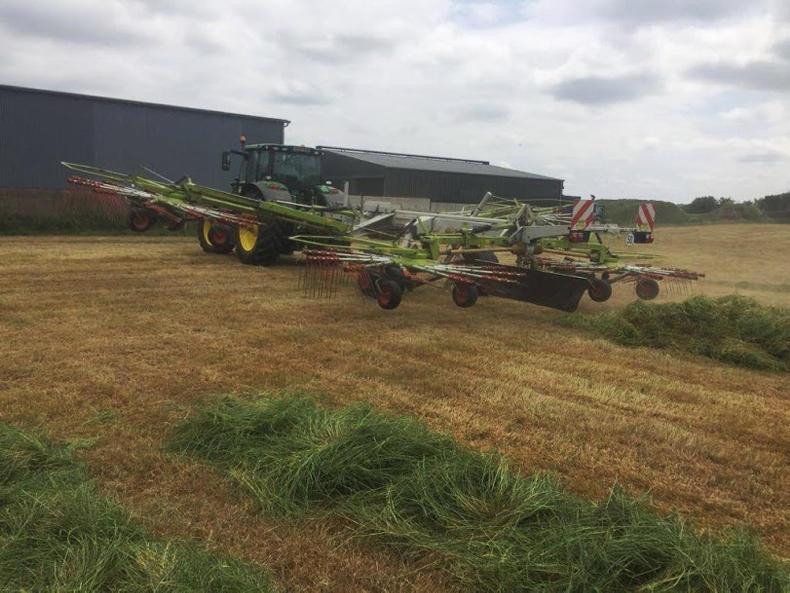
Michael Quigley's Claas Liner 3600 rake
Claas Liner 3600
Michael Quigley based in Monasterevin, Co Kildare, is another contractor who upgraded to a four-rotor rake two seasons ago. Michael made the move to a Claas Liner 3600 four-rotor rake in 2017 after having run a Claas Liner 2800 twin-rotor for a number of years.
He decided to keep his Liner 2800 after buying the new rake to rake for his balers and in case the larger rake didn’t fit into some fields. But to his surprise the new larger rake worked for every customer. The Liner 3600 got in and out of gateways as easily as his older Liner 2800 because of its centralised axle.
When purchasing the rake, Michael had plans to change his 2016 Jaguar 870 to a new 970 for the following season (2018). He said the plan to increase harvester size would give him scope to lift larger rows of grass comfortably. The 870 managed for the one season, albeit travelling that bit slower than he does now in the 970, currently averaging speeds of 8-10km/h. Michael said the machine’s intake volume is more important to him than increased forward speeds.
The new rake lifts four 10ft rows of grass compared to three rows with the older rake, and the new rake moves each of the four rows, whereas the old rake essentially pulled the two outer rows in on top of the middle row. Grass is lifted more easily with the harvester’s pickup because all rows have been moved and so, cleaning the ground better as the middle row of grass is no longer lying flat on the ground.
Grouping four rows together at a time or 12.5m of tedded grass compared to three rows or 8.2m with the older rake eliminates the need for a third headland run while still having adequate space for turning. Now there are only two headland rows, although covering a greater area means corners are not as sharp. Michael said: “Trailers are filling quicker as I can constantly be lifting grass, losing no time on headland runs.”
Having tested a Liner 4000 for a period of time, Michael found it to be a less refined machine with more moving parts he didn’t find were completely necessary when compared to the Liner 3600. The Liner 4000 also proved much harder to manoeuvre in comparison to the Liner 3600, taking into account its larger working width. Michael made a point of noting that if the Liner 3600 could be redesigned to extend its front two rotors to working widths of the Liner 4000 it would be the ideal machine.
Both contractors are impressed with how the larger machines have worked and would not go back to twin-rotor rakes, though it is worth noting that twin-rotor rakes still have a place in most contractors’ fleets. Four-rotor rakes are more expensive than twin-rotor rakes, so it really comes down to what suits each individual contractor’s needs and budget.
The average horsepower of silage harvesters in Ireland has increased in recent years. This is often due to challenging weather conditions leaving contractors to gather up more grass in a shorter time period. This higher throughput requires greater-capacity machines. Farmers cutting grass early in the season generally look for quality and maybe an extra cut; this leaves lighter crops on the ground in a lot of cases.
In recent years, contractors have been making the move to larger rakes to speed up the process as more grass is being grouped into the one row, resulting in less driving.

Stephen Mohan's Krone Swadro 1400 and New Holland T7.235
Krone Swadro 1400
Stephen Mohan is a contractor based in Navan, Co Meath. He operates a Krone Swadro 1400 four-rotor rake after moving from a Swadro 900. Stephen said his main reasons for opting for the larger rake was that crops were lighter due to earlier cutting, as his customers were focusing more on quality. He said: “Farmers were cutting that bit earlier, crops were lighter and we found ourselves chasing the rows around the field.” They now work at steadier speeds and lift greater volumes of grass.
Stephen’s Krone 1400 rake is capable of pulling in 13.5m of tedded grass or five 10ft rows of grass into one row, with his previous Swadro 900 capable of pulling in 30ft of tedded grass or three 10ft rows.
Having run the larger rake for two full seasons, Stephen reckons it has many benefits, one being its ability to keep further ahead of the harvester now than before, raking 25 acres an hour in the right fields. Raking a larger quantity of grass at a time means he can afford to travel slower, generally 8-10km/h, he said. Before he was operating the old rake quicker to keep ahead. Now the larger rake is raking at its ease and, having had no maintenance issues so far, he believes this is the key to maintaining a rake.
Stephen noted the larger rake proved more manoeuvrable than he had thought. He said his customers are happier with it from a compaction point of view because larger widths of grass are being pulled into one row, resulting in fewer rows and less travelling. He can make better use of his tractors as raking takes less time, leaving the raking tractor free to pull a trailer and do other jobs.

Michael Quigley's Claas Liner 3600 rake
Claas Liner 3600
Michael Quigley based in Monasterevin, Co Kildare, is another contractor who upgraded to a four-rotor rake two seasons ago. Michael made the move to a Claas Liner 3600 four-rotor rake in 2017 after having run a Claas Liner 2800 twin-rotor for a number of years.
He decided to keep his Liner 2800 after buying the new rake to rake for his balers and in case the larger rake didn’t fit into some fields. But to his surprise the new larger rake worked for every customer. The Liner 3600 got in and out of gateways as easily as his older Liner 2800 because of its centralised axle.
When purchasing the rake, Michael had plans to change his 2016 Jaguar 870 to a new 970 for the following season (2018). He said the plan to increase harvester size would give him scope to lift larger rows of grass comfortably. The 870 managed for the one season, albeit travelling that bit slower than he does now in the 970, currently averaging speeds of 8-10km/h. Michael said the machine’s intake volume is more important to him than increased forward speeds.
The new rake lifts four 10ft rows of grass compared to three rows with the older rake, and the new rake moves each of the four rows, whereas the old rake essentially pulled the two outer rows in on top of the middle row. Grass is lifted more easily with the harvester’s pickup because all rows have been moved and so, cleaning the ground better as the middle row of grass is no longer lying flat on the ground.
Grouping four rows together at a time or 12.5m of tedded grass compared to three rows or 8.2m with the older rake eliminates the need for a third headland run while still having adequate space for turning. Now there are only two headland rows, although covering a greater area means corners are not as sharp. Michael said: “Trailers are filling quicker as I can constantly be lifting grass, losing no time on headland runs.”
Having tested a Liner 4000 for a period of time, Michael found it to be a less refined machine with more moving parts he didn’t find were completely necessary when compared to the Liner 3600. The Liner 4000 also proved much harder to manoeuvre in comparison to the Liner 3600, taking into account its larger working width. Michael made a point of noting that if the Liner 3600 could be redesigned to extend its front two rotors to working widths of the Liner 4000 it would be the ideal machine.
Both contractors are impressed with how the larger machines have worked and would not go back to twin-rotor rakes, though it is worth noting that twin-rotor rakes still have a place in most contractors’ fleets. Four-rotor rakes are more expensive than twin-rotor rakes, so it really comes down to what suits each individual contractor’s needs and budget.






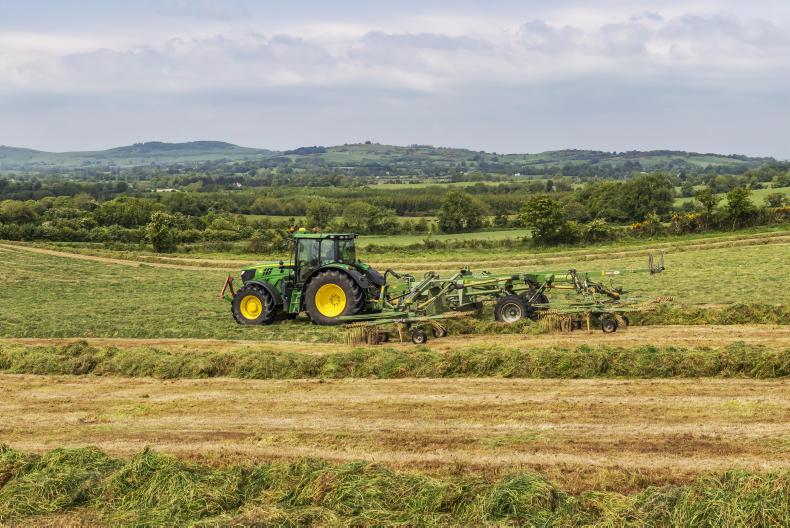
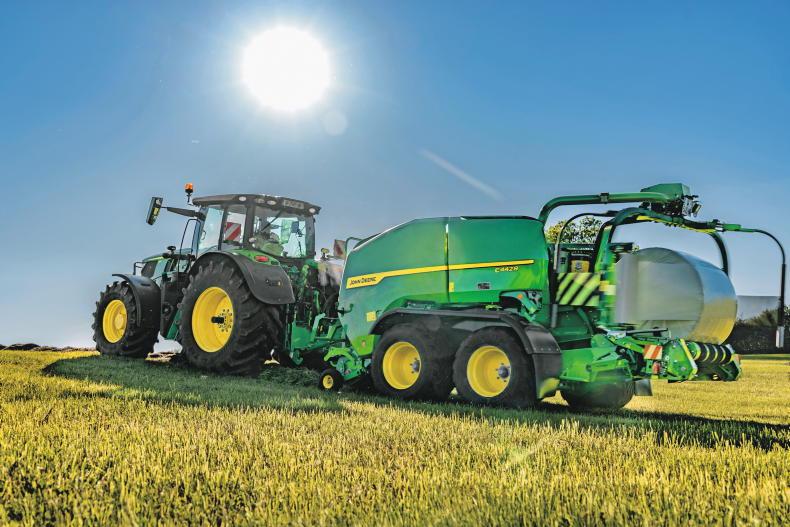

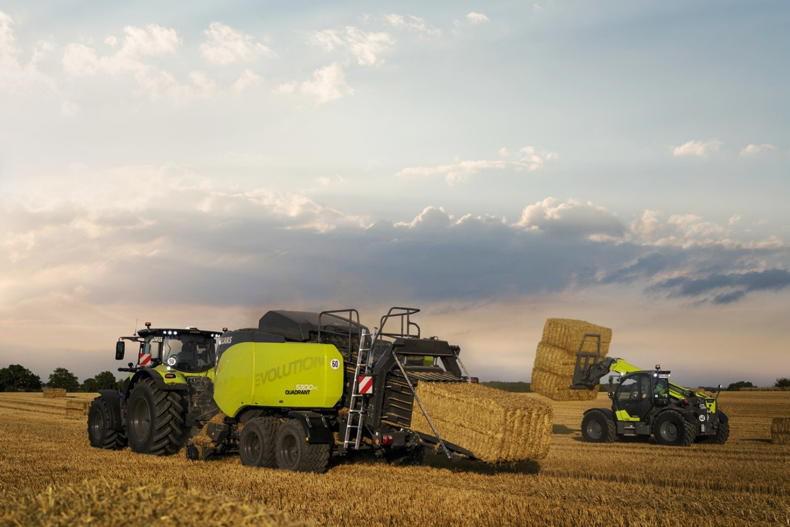

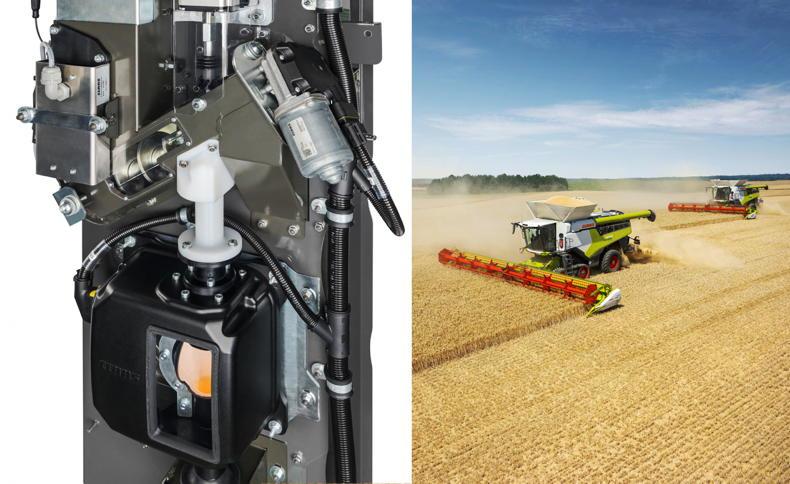
SHARING OPTIONS